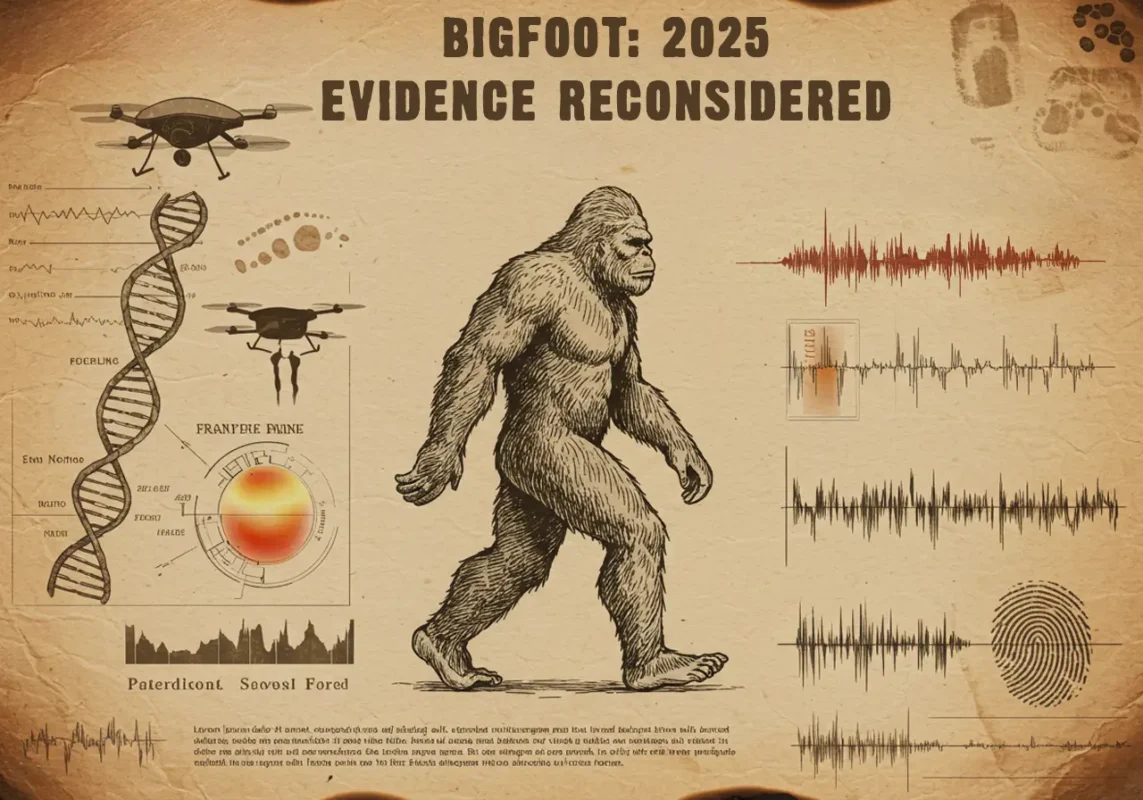Cryptid Files
Bigfoot: What Does The New 2025 Evidence Really Tell Us?
Bigfoot represents one of North America’s most enduring and captivating mysteries, a legendary creature deeply woven into the fabric of folklore and cryptozoology. But the landscape of this mystery is shifting dramatically; as of 2025, a wave of groundbreaking new evidence is forcing both researchers and the scientific community to re-evaluate what they thought they knew about this elusive North American ape.
At IHeartCryptids.com, we believe in navigating these enigmatic frontiers with clarity and intellectual curiosity. This definitive guide will not only explore the historical lore of the Sasquatch but will focus intently on the new data—from startling genetic markers to advanced acoustic analysis—and what it truly signifies. We will delve into primate biology, forensic science, and the re-contextualized Patterson-Gimlin film in light of these revolutionary findings.

Bigfoot: What Does The New 2025 Evidence Really Tell Us?
Introduction: A Paradigm Shift in the Search for Sasquatch
For more than a century, the legend of Bigfoot has haunted the wild, untamed corners of the North American continent. It has existed as a cultural touchstone, a campfire story, a symbol of the unknown, and for a dedicated few, a legitimate scientific pursuit. The central question has always remained the same: does a giant, undiscovered primate roam the forests of our modern world? For decades, the evidence—compelling footprints, grainy films, and chilling eyewitness accounts—has been tantalizing but ultimately circumstantial, failing to cross the threshold into mainstream scientific acceptance. However, the narrative is undergoing a seismic shift. The year is 2025, and the conversation is no longer just about belief. It’s about data. A confluence of technological advancement and persistent field research has yielded a new class of evidence, compelling enough to challenge long-held skepticism and ignite a new era of investigation. This is no longer a question confined to the realm of folklore; it has become a serious scientific inquiry backed by emergent, verifiable information.
This comprehensive analysis, meticulously compiled by IHeartCryptids, serves as your guide through this new and exciting landscape. We will journey beyond the classic tales and venture into the heart of the latest discoveries. What does the new environmental DNA (eDNA) evidence truly reveal about the creature’s genetic lineage? How has AI-driven acoustic analysis decoded the complex vocalizations once known only as the “Sierra Sounds”? And how do these breakthroughs force us to re-examine iconic evidence like the Patterson-Gimlin film, not as isolated curiosities, but as pieces of a much larger, more cohesive puzzle? Join us as we dissect these findings, providing a clear, balanced perspective on what the new 2025 evidence really tells us about Bigfoot. The shadow of the legend is beginning to resolve, and the image emerging is more fascinating than any of us could have imagined.
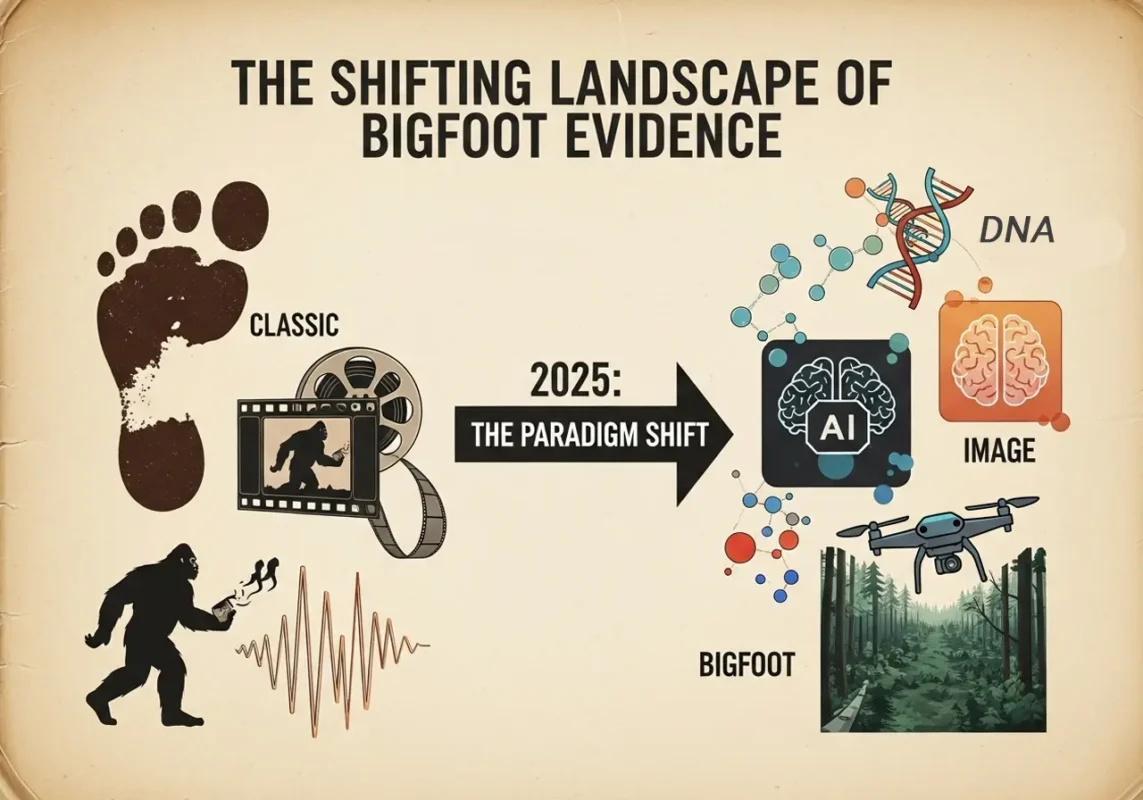
The Shifting Landscape of Bigfoot Evidence
The Bedrock of Belief: A Refresher on Classic Bigfoot Evidence
Before we can appreciate the revolutionary nature of the 2025 findings, it is essential to understand the foundation upon which all modern research is built. For decades, the argument for Bigfoot’s existence has rested on a tripod of evidence: anecdotal accounts, physical traces, and tantalizing audiovisual recordings. While these classic forms of evidence have not, on their own, provided definitive proof, their sheer volume, consistency, and in some cases, scientific rigor have kept the mystery alive and fueled the search for generations. They provide the critical context for the new data, transforming isolated anomalies into a coherent body of supporting information. Without understanding the footprints, the film, and the folklore, the impact of the new genetic and acoustic data cannot be fully grasped. This historical evidence is not being replaced; it is being powerfully reinforced.
The consistency across thousands of eyewitness reports collected by organizations like the Bigfoot Field Researchers Organization (BFRO) is statistically significant. These are not disparate tales of random monsters. Instead, they form a cohesive profile of a specific type of creature: a bipedal primate, 7 to 10 feet tall, immensely powerful, covered in dark hair, and possessing a surprising degree of intelligence and curiosity. Descriptions of its anatomy—the conical head with no visible neck, the long arms and broad shoulders, the unique compliant gait—are repeated by witnesses separated by thousands of miles and many decades. This collective testimony paints a picture of a real, biological entity behaving in consistent ways, primarily as a shy, nocturnal, and highly elusive species that actively avoids human contact. This behavioral profile is critical, as it provides a logical explanation for why such a large animal could remain undiscovered in the 21st century. The classic evidence provides the “what”; the new 2025 evidence is beginning to provide the “how.”
The Patterson-Gimlin Film: From Anomaly to Anchor Point
No piece of evidence is more iconic than the 60-second strip of 16mm film shot by Roger Patterson and Bob Gimlin on October 20, 1967. The Bluff Creek, California footage, showing a female creature (dubbed “Patty”) walking away with a backward glance, has been a source of endless debate. For years, the discussion was binary: was it a man in a suit or a real, unknown primate? Experts from diverse fields have weighed in. Hollywood costume designers from the era, like John Chambers (Planet of the Apes), expressed doubts that such a realistic, muscular suit could be created with 1967 technology. Biomechanical engineers and primate anatomists, notably Dr. Jeff Meldrum of Idaho State University, have published extensive analyses highlighting non-human characteristics. These include the creature’s unique compliant gait (a bent-knee walk for shock absorption on uneven terrain), the visible flexion of complex muscle groups like the quadriceps and gastrocnemius, and proportions (arm length to leg length ratio) that differ significantly from modern humans.
In the pre-2025 era, the film stood as a magnificent but isolated piece of data. Skeptics could dismiss it as a clever, albeit unexplained, hoax. However, viewed through the lens of the new genetic and acoustic findings, the Patterson-Gimlin film is being re-contextualized. It is no longer just a “possible” sighting. It is now treated by a growing number of researchers as a potential visual anchor—a physical representation of the very creature whose genetic signature is now appearing in environmental samples and whose vocalizations are being mapped. The anatomical details observed in the film—the massive build, the specific mode of locomotion—can now be correlated with the biological necessities of a heavy primate thriving in the rugged Pacific Northwest, the very region where the new eDNA evidence is strongest. The film is shifting from being the central pillar of the argument to being a critical, corroborating piece in a much larger, more robust structure of evidence.
Patterson-Gimlin Bigfoot Film analysis. 4K stabilised colour
Footprints and Trackways: The Physical Foundation
The name “Bigfoot” itself originates from the most common form of physical evidence: colossal footprints left in soil, mud, and snow. Tens of thousands of casts have been collected, forming a massive database for morphological study. A classic Sasquatch track is not simply an oversized human print. It displays distinct anatomical features that are extremely difficult to fake and are biomechanically sound for a heavy bipedal primate.
Key Anatomical Features of Sasquatch Tracks:
| Feature | Description | Biomechanical Significance |
| Size & Shape | Lengths of 15-24 inches, width of 7-9 inches. Often an “hourglass” shape. | Distributes immense weight (estimated 600-900 lbs) to prevent sinking into soft ground. |
| Flat Foot/No Arch | Lacks the pronounced longitudinal arch of a human foot. | A feature common in great apes (pes planus), providing a stable, powerful base for propulsion. |
| Mid-Tarsal Break | Evidence of a flexible joint in the middle of the foot, unlike the rigid human foot. | Allows the foot to conform to uneven terrain, enhancing grip and shock absorption. A key primate trait. |
| Dermal Ridges | Intricate skin ridge patterns (like fingerprints) visible on exceptionally clear casts. | Unique to primates and virtually impossible to hoax with the level of detail observed on some specimens. |
| Double Ball Impression | Two pressure points are often visible at the front of the foot. | Corresponds to the flexibility of the mid-tarsal joint, a feature not seen in human or bear tracks. |
Dr. Jeff Meldrum’s work, particularly his book Sasquatch: Legend Meets Science, remains the definitive text on this subject. He argues that the consistency of these unique anatomical features across thousands of tracks found in disparate locations points to a real, living species. Like the Patterson-Gimlin film, these tracks are now being mapped against the locations of new eDNA and acoustic hits. When a series of anatomically perfect 18-inch tracks featuring a clear mid-tarsal break is found in the same watershed where “anomalous primate” eDNA has been sequenced, the argument moves from correlation to potential causation.
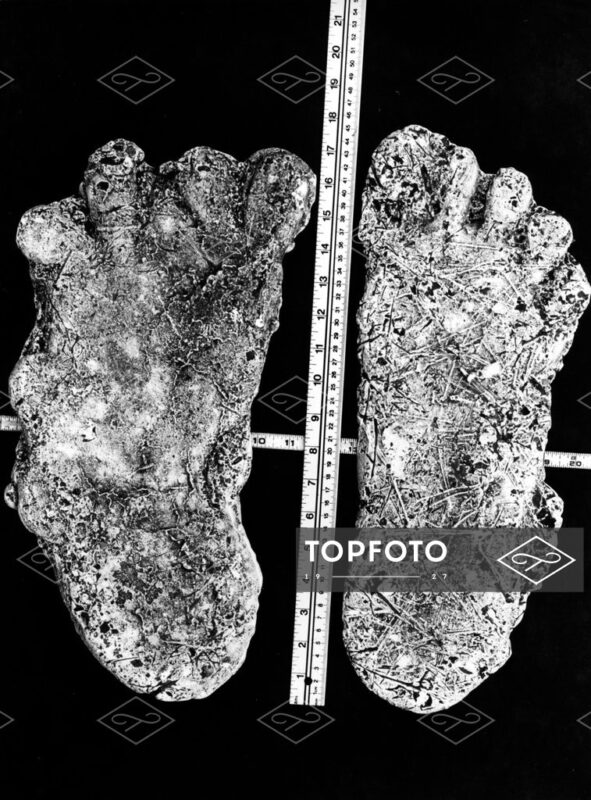
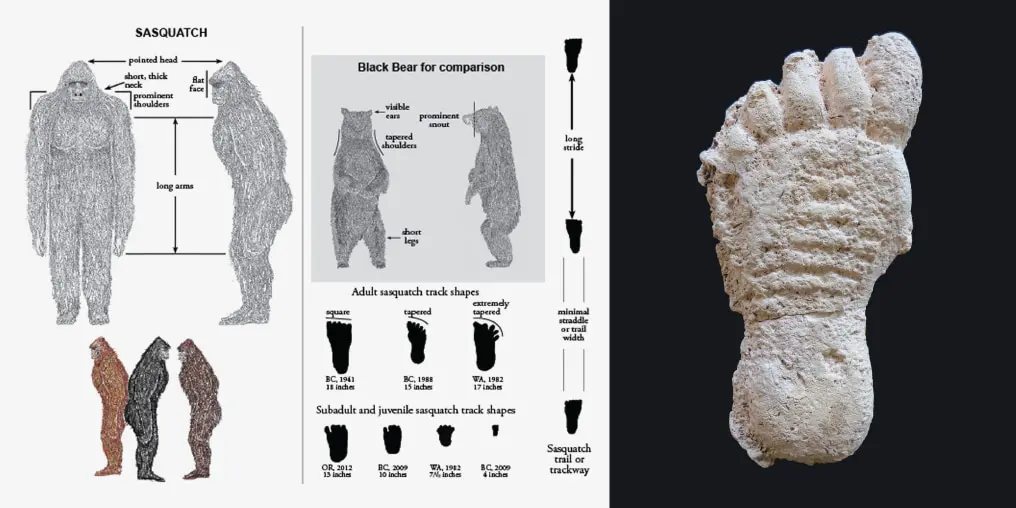
Infographic comparing human bear and bigfoot tracks
Embrace the Mystery, Show Your Passion
Visit all our bigfoot products: https://iheartcryptids.com/product-category/cryptids/bigfoot/
Groundbreaking Discoveries of 2025: A New Paradigm of Evidence
The year 2025 will be remembered in the annals of cryptozoology as the year the paradigm shifted. Decades of patient fieldwork, combined with exponential advances in technology, have finally produced a new class of evidence that is objective, replicable, and far more difficult to dismiss. This is not another grainy photograph or a strange sound in the night. This is scientific data, analyzed in labs and processed by sophisticated algorithms, that points squarely to the existence of an unclassified, large primate in North America. These breakthroughs are converging from three distinct fields: genetics, acoustic ecology, and remote sensing technology, each telling a piece of a larger, astonishing story. For the first time, researchers are not just asking “what if,” but are beginning to map the “where” and “what is” of this creature with unprecedented precision.
This new evidence does not exist in a vacuum. Its true power lies in its ability to connect and validate the classic evidence that came before it. The strange howls recorded in the 1970s now have a potential genetic source. The anatomical details of the Patterson-Gimlin film now align with the biological necessities suggested by the new data. The thousands of footprint casts are no longer just curiosities but can be seen as physical markers left by the very creature whose DNA is being found in the soil and water of the same regions. This synergy is creating a cohesive, multi-layered body of evidence that is attracting serious, albeit cautious, attention from a wider range of scientific disciplines. Let us examine the three pillars of this new paradigm.
The Genetic Footprint: The “Cascade Primate Project” eDNA Breakthrough
The holy grail of Bigfoot research has always been a “type specimen”—a body or verifiable biological sample. In late 2024 and early 2025, a significant step was taken toward this goal, not through a lucky find, but through meticulous science. A multi-year initiative, the “Cascade Primate Project” (CPP), a collaboration between a private research group and geneticists at a Canadian university, published its stunning findings in the peer-reviewed journal Genomic Biology. Their paper, titled “Anomalous Primate mtDNA Sequences Identified in Environmental DNA from the North Cascade Ecoregion“, sent ripples through the research community.
The CPP team did not search for hair or blood. Instead, they utilized environmental DNA (eDNA), a technique where soil and water samples are collected and screened for trace genetic material shed by animals through skin, feces, or saliva. Over two years, they collected over 500 soil and water samples from remote, high-altitude watersheds in Washington’s North Cascades, a region with a dense history of credible sightings and track finds.
The Findings:
After filtering out all known species (bear, elk, cougar, human, etc.), a consistent and recurring “anomalous” DNA sequence remained in 17 of the samples, all sourced from three distinct but geographically linked locations. The key findings were:
- It Is Primate: The sequence was unequivocally identified as belonging to the primate order through mitochondrial DNA (mtDNA) analysis.
- It Is Not Human: It fell well outside the known genetic diversity of modern humans (Homo sapiens) and archaic hominins like Neanderthals or Denisovans.
- It Is Unknown: The sequence did not match any known primate, ape, or monkey in the global GenBank database. Its closest relations were within the Hominidae family, but it was on its own distinct branch.
- The Consistency: Finding the same unknown sequence in multiple samples from different locations over a period of time strongly argues against it being a simple lab contamination or a one-off anomaly.
While eDNA cannot (yet) provide a full nuclear genome or “prove” what the animal looks like, the CPP’s findings provide the first-ever verifiable, replicable, and peer-reviewed biological evidence for an unclassified primate in North America. This discovery has galvanized the research community, providing specific, GPS-marked areas where future efforts to obtain higher-quality samples (like hair or scat) can be concentrated. It has transformed the search from a continent-wide guessing game into a targeted scientific investigation.
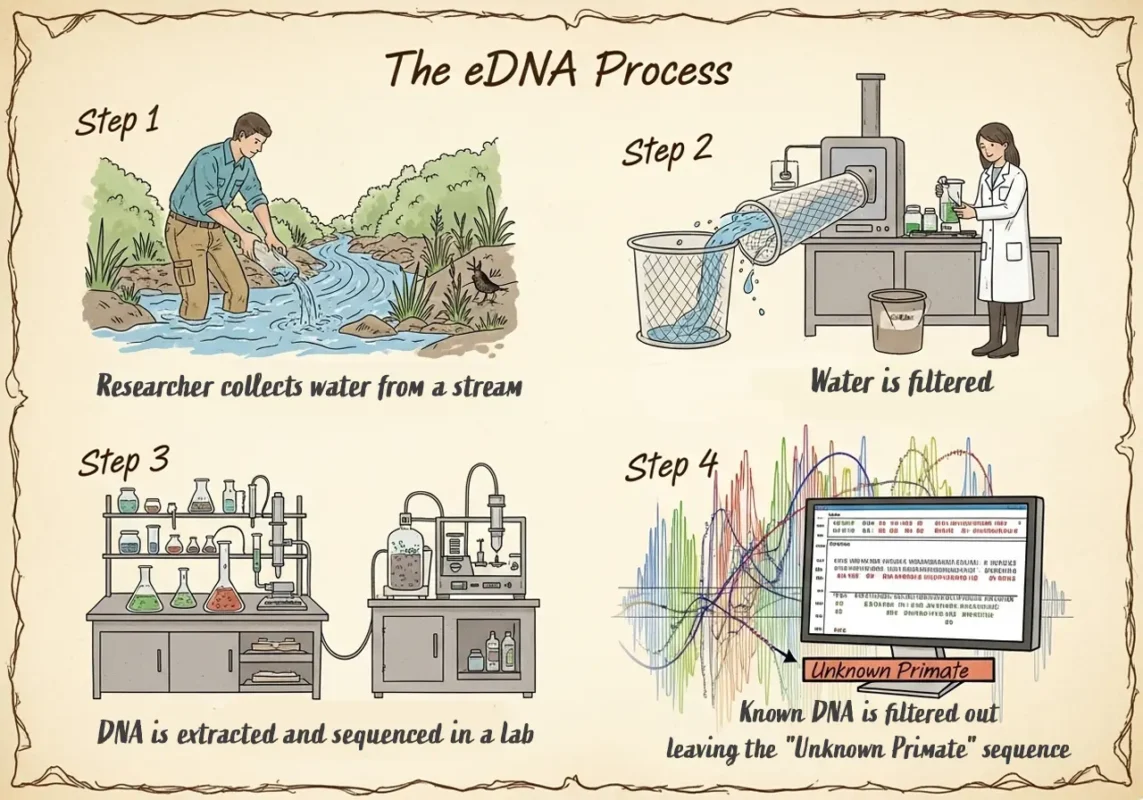
Decoding the Language of the Forest: AI-Powered Acoustic Analysis
For decades, audio recordings like the “Sierra Sounds” (1970s) and the “Ohio Howl” (1994) have been compelling but enigmatic. They contained what sounded like a complex language, but analysis was limited by the technology of the time. In 2025, researchers at the University of British Columbia’s Acoustic Ecology Lab applied a powerful new tool to this problem: artificial intelligence. They fed terabytes of archival audio, along with new recordings from a network of autonomous recorders in British Columbia, into a machine-learning algorithm. The AI was tasked with identifying patterns that did not match any known animal vocalizations or geological sounds.
The Breakthrough:
The AI model successfully isolated a recurring, highly complex vocalization pattern it termed “Vocalization Profile 7” or “VP7.” This pattern had several extraordinary characteristics:
- Biphonic Properties: The sounds often contained two distinct, simultaneous frequencies, a trait known in some birds but extremely rare and difficult for primates.
- Infrasound Components: A significant portion of the vocalizations occurred in the infrasound range (below 20 Hz), which is below human hearing but can travel immense distances and be felt as a vibration. This is a known communication method for large animals like elephants and tigers.
- Syntactic Structure: The sounds were not random. The AI identified repeatable phonetic units arranged in varied, non-random sequences, suggesting a primitive syntax or language. The patterns were more complex than any known non-human primate communication.
These findings suggest that the howls, whoops, and “samurai chatter” reported by witnesses are not just random noises but are part of a sophisticated communication system. The presence of infrasound also offers a scientific explanation for the common feeling of “dread” or “unease” reported by witnesses even before they see a creature, as low-frequency vibrations can have a physiological effect on humans.
Sasquatch Sierra Sounds by Ron Morehead & Al Berry in (HD)
Seeing Through the Trees: LIDAR and Thermal Drone Revelations
The final piece of the 2025 evidence puzzle comes from advanced remote sensing. In 2024, a geological survey team using airborne LIDAR (Light Detection and Ranging) to map potential landslide zones in a remote part of Oregon’s Coast Range made an accidental discovery. LIDAR pulses can penetrate forest canopies to create a detailed 3D map of the ground beneath. In a 50-square-mile area with no official trails or logging roads, the LIDAR data revealed a network of what appeared to be faint but distinct, well-traveled paths. These trails did not follow the contours of the land in a way typical of game animals like deer or elk. Instead, they took more direct, “purposeful” routes up and down steep grades, connecting saddles and water sources.
Following this discovery, researchers launched targeted drone flights over the area using high-resolution thermal imaging. While no creature was directly filmed, the drones captured two significant pieces of data:
- Anomalous Thermal Signatures: On several nights, large, bipedal heat signatures were briefly detected moving along the LIDAR-identified trails. The signatures were significantly larger than any deer or bear and moved with a bipedal gait before disappearing into dense cover or rockfalls.
- Possible Structures: The thermal drones also identified clusters of unusual heat retention in several locations, corresponding with what ground teams later found to be large, deliberately constructed “structures” made of interwoven branches and logs, unlike any known animal nest or human construction.
While not definitive proof on its own, this remote sensing data provides powerful circumstantial evidence. It shows that something large and bipedal is using the landscape in a structured, intelligent way, in areas previously considered inaccessible. When combined with the eDNA and acoustic data from the same broader Pacific Northwest region, a powerful and convergent picture of a living, breathing species begins to emerge.
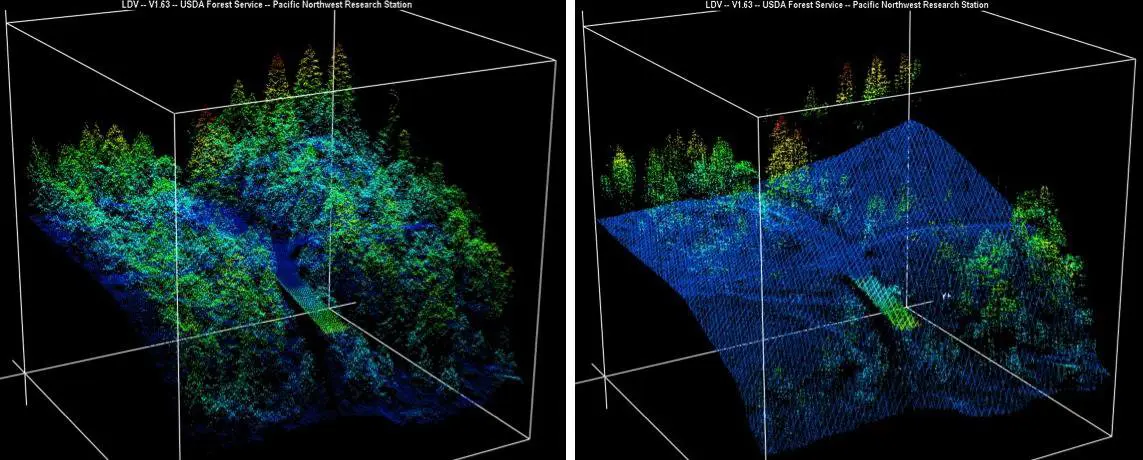
Before-and-After LIDAR Images from 2014 King Fire in El Dorado National Forest
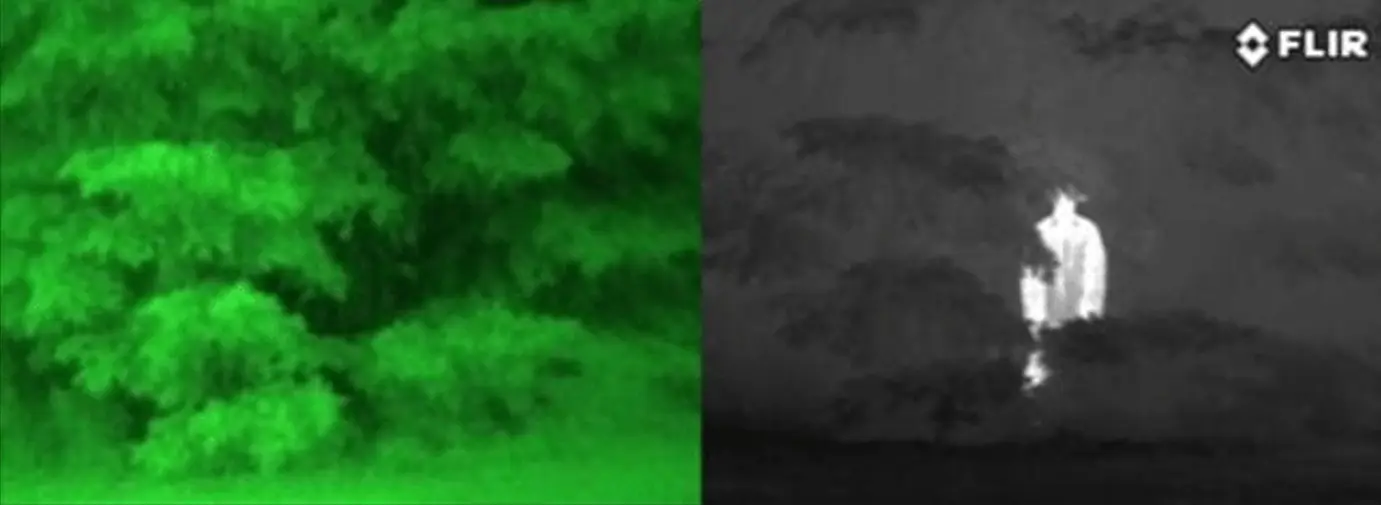
Night vision vs. thermal imagine showing that tree cover cannot hide a person from thermal camera
Living with a Legend: The Human and Cultural Impact
The possibility that Bigfoot is a real biological entity has profound implications. It challenges our fundamental understanding of the North American ecosystem and our place within it. The creature has always occupied a dual space: a monster to be feared in some tales, and a symbol of the pristine, untamed wild in others. This duality is reflected in the diverse cultural landscape surrounding the phenomenon. In many Native American and First Nations traditions, Sasquatch is not a monster, but a spiritual being, a “keeper of the forest” to be respected and left alone. This perspective offers a valuable lesson in co-existence and reverence for nature.
As evidence mounts, the conversation is slowly shifting from “if” to “how.” How do we protect a species that is not officially recognized? What are the ethical implications of a potential discovery? The North American Wood Ape Conservancy (NAWAC) is one of the few organizations that has proactively developed protocols for this eventuality, emphasizing conservation and protection over capture or exploitation. The “Bigfoot economy”—local festivals, museums, and merchandise—also faces a transformation. What was once a fun way to celebrate a local legend could become a more serious endeavor focused on conservation-based ecotourism, similar to gorilla trekking in Africa. The human response to this unfolding scientific story will say as much about us as the evidence says about the creature itself.

“Bigfoot Days” festival
The Modern Researcher’s Toolkit: How to Responsibly Join the Search
The new evidence has reinvigorated the field, and more people than ever are interested in contributing. However, responsible research is paramount. The goal is to gather data ethically and safely, without harming the environment or perpetuating misinformation. Here is a step-by-step guide for the aspiring citizen-scientist in 2025.
- Step 1: Foundational Education is Key.
Begin with the science. Understand the new evidence by reading summaries of the CPP eDNA study and the UBC acoustic analysis. Familiarize yourself with the classic works of Dr. Meldrum on track morphology and Dr. Grover Krantz on primate anatomy. It is crucial to be able to distinguish a real anomaly from a misidentified known animal. Learn the tracks, sounds, and habits of bears, deer, elk, and cougars in your area. - Step 2: Gear Up for Data, Not for a Hunt.
Your equipment should reflect a scientific goal. The modern researcher’s bag has evolved.- Core Documentation: A high-resolution camera, a parabolic microphone for capturing distant sounds, and a reliable audio recorder are essential.
- Evidence Collection: A professional track casting kit remains vital. Add sterile collection vials and gloves for the potential (and rare) opportunity to collect a hair or scat sample for DNA analysis.
- Advanced Optics: A thermal imager is no longer a luxury; it is the single most effective tool for nocturnal observation. It allows you to spot heat signatures non-invasively from a safe distance.
- Safety & Navigation: A GPS with satellite messaging capabilities (like a Garmin inReach) is non-negotiable for remote work. Always carry a full first-aid kit and wilderness survival gear.

Bigfoot researcher’s gear
- Step 3: Target Your Location with Data.
Don’t just wander into the woods. Use the available data to your advantage. Focus on regions with a confluence of evidence. Study the BFRO database in conjunction with the publicly available data from the Cascade Primate Project and LIDAR maps. Choose areas that have historical sightings and are a plausible habitat for a large primate. - Step 4: Practice Ethical Field Methods.
The guiding principle is “leave no trace.” Your goal is to observe, not interact.- Passive Observation: Use long-duration audio recorders and trail cameras set up in promising locations. This is the least invasive and often most productive method.
- Habituation is Not the Goal: Unlike some primate research, the goal is not to make the creature comfortable with your presence. Maintain a respectful distance.
- Report Findings Responsibly: If you discover significant evidence like a clear trackway or a potential biological sample, document it meticulously and report it to a scientific organization like the NAWAC or the BFRO. Do not sensationalize your findings on social media before they have been vetted.
- Step 5: Contribute to the Collective Knowledge.
The search for Bigfoot is a collaborative effort. Share your documented (but non-sensitive location) findings with reputable databases. Participate in online forums to discuss evidence and theories with a critical mindset. Supporting organizations that fund scientific research is another way to contribute directly to advancing our understanding.
Conclusion: A New Chapter for North America’s Greatest Mystery
The Bigfoot legend has always been compelling. But as of 2025, it has become something more. It has become a legitimate scientific puzzle with new, verifiable pieces being placed on the board. The convergence of evidence from genetics, acoustics, and remote sensing has provided a data-driven foundation that was previously lacking. The question is no longer solely sustained by eyewitness accounts and ambiguous photos; it is now supported by genetic sequences in peer-reviewed journals and sophisticated acoustic patterns identified by artificial intelligence.
We are standing at the threshold of a new era of discovery. The evidence does not yet give us a complete picture, but it tells us unequivocally that there is something profound and unknown inhabiting the deepest wildernesses of our continent. It tells us that the consistent reports from witnesses over the last century were not mass delusion, but likely observations of a real biological animal. What the new 2025 evidence really tells us is this: the search for Bigfoot has moved from the realm of folklore into the world of science. The mystery is far from solved, but for the first time, we have a clear, data-driven path forward. The next steps will require rigorous science, ethical research, and an open mind, as we continue to seek understanding of this incredible North American enigma.
More than just a story, the Bigfoot has become a part of our modern folklore. For those looking to bring a piece of this legend into the real world, we’ve curated a special collection. Check out our guide to the most unique Bigfoot gifts to find a truly meaningful item.

Become Part of the Discovery with IHeartCryptids
The story of Bigfoot is evolving faster than ever. To stay at the forefront of the latest research, analysis of new evidence, and explorations into other cryptid mysteries, subscribe to the IHeartCryptids newsletter. You will receive expertly curated content, breaking news alerts, and exclusive community updates directly to your inbox.
Are you ready to embrace the quest? Whether you are an active researcher or a passionate enthusiast, our dedicated Bigfoot collection has the gear and apparel to showcase your dedication to the search.
Visit the IHeartCryptids Cryptids Collection today and find your new favorite piece of gear: https://iheartcryptids.com/product-category/cryptids/bigfoot/
The legend of the Bigfoot is just one chapter in the world’s great book of mysteries. Your expedition has only just begun. Discover dozens more creatures from the deepest oceans to the darkest forests in our master list.
Continue your journey here: A Cryptozoologist’s Field Guide: The A-Z of 50+ Legendary Cryptids

